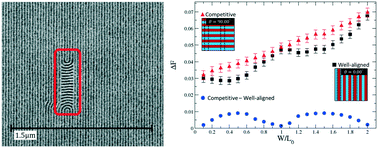当前位置:
X-MOL 学术
›
Mol. Syst. Des. Eng.
›
论文详情
Our official English website, www.x-mol.net, welcomes your
feedback! (Note: you will need to create a separate account there.)
Design of surface patterns with optimized thermodynamic driving forces for the directed self-assembly of block copolymers in lithographic applications
Molecular Systems Design & Engineering ( IF 3.2 ) Pub Date : 2017-08-03 00:00:00 , DOI: 10.1039/c7me00028f Grant P. Garner 1, 2, 3, 4, 5 , Paulina Rincon Delgadillo 1, 2, 3, 4, 5 , Roel Gronheid 4, 5, 6 , Paul F. Nealey 1, 2, 3 , Juan J. de Pablo 1, 2, 3
Molecular Systems Design & Engineering ( IF 3.2 ) Pub Date : 2017-08-03 00:00:00 , DOI: 10.1039/c7me00028f Grant P. Garner 1, 2, 3, 4, 5 , Paulina Rincon Delgadillo 1, 2, 3, 4, 5 , Roel Gronheid 4, 5, 6 , Paul F. Nealey 1, 2, 3 , Juan J. de Pablo 1, 2, 3
Affiliation

|
It is well established by theory and experiment that lamella-forming block copolymers with characteristic periodicity, L0, can assemble into lines-and-spaces over carefully crafted chemically patterned substrates composed of stripes of width W that repeat with period LS. While previous works measured the efficacy of pattern designs for self-assembly through visual inspection of experimental images or examination of morphologies obtained from simulations, here we combine visual inspection over a large number of processing conditions with a new theoretical strategy that quantitatively measures the thermodynamic driving force of chemical patterns to produce a single grain of lines-and-spaces. The metric we use to describe the thermodynamic driving force is defined by the free-energy difference between the desired assembly of lines-and-spaces and the grain orientation with the lowest energy, referred to as the most competitive assembly. Visualization of experimental systems using SEM imaging provides a first-order approximation of the process windows in pattern design space in regard to W and the chemical contrast of the stripes and the background region, where the thermodynamic driving force is large enough to eliminate competitive grains. The strategy proposed in this work then uses complementary molecular simulations to elucidate which combination of these pattern parameters provides the largest driving force through free-energy calculations obtained by thermodynamic integration and attempts to identify which pattern designs minimize the probability of assembling lamellae that are stabilized at undesired angles to the patterned stripes. The combination of experiment and theory shows that narrow guiding stripes with width 0.4 ≤ W/L0 ≤ 0.8 that are highly preferential for one of the blocks are best for obtaining a directed self-assembly process flow with the highest probability of assembling a desired grain orientation.
中文翻译:

具有最佳热力学驱动力的表面图案设计,用于石版印刷应用中嵌段共聚物的定向自组装
通过理论和实验已很好地确定,具有周期性特征层L 0的成片嵌段共聚物可以在精心制作的化学图案化基材上组装成线和空间,这些基材由宽度W的条纹组成,并重复周期L S。尽管先前的工作通过视觉检查实验图像或检查从模拟获得的形态来测量图案设计自组装的功效,但在这里,我们将在大量加工条件下的视觉检查与定量测量热力学驱动力的新理论策略相结合。化学图案的力产生单粒的线和空间。我们用来描述热力学驱动力的度量标准是由所需的线和空间装配与具有最低能量的晶粒取向之间的自由能差(称为最有竞争力的装配)定义的。使用SEM成像的实验系统的可视化提供了图案设计空间中关于W的过程窗口的一阶近似值以及条纹和背景区域的化学对比,在此处热力学驱动力足够大,可以消除竞争颗粒。然后在这项工作中提出的策略使用互补分子模拟来阐明这些模式参数的哪种组合通过通过热力学积分获得的自由能计算来提供最大的驱动力,并试图确定哪些模式设计将组装在与图案条纹不希望的角度。该缩小与宽度0.4≤引导条纹的实验和理论示出了组合W¯¯ /大号0 ≤0.8(对于其中一个模块而言是高度优先的)最适合于获得定向的自组装工艺流程,并具有最高的组装所需晶粒取向的可能性。
更新日期:2017-08-03
中文翻译:

具有最佳热力学驱动力的表面图案设计,用于石版印刷应用中嵌段共聚物的定向自组装
通过理论和实验已很好地确定,具有周期性特征层L 0的成片嵌段共聚物可以在精心制作的化学图案化基材上组装成线和空间,这些基材由宽度W的条纹组成,并重复周期L S。尽管先前的工作通过视觉检查实验图像或检查从模拟获得的形态来测量图案设计自组装的功效,但在这里,我们将在大量加工条件下的视觉检查与定量测量热力学驱动力的新理论策略相结合。化学图案的力产生单粒的线和空间。我们用来描述热力学驱动力的度量标准是由所需的线和空间装配与具有最低能量的晶粒取向之间的自由能差(称为最有竞争力的装配)定义的。使用SEM成像的实验系统的可视化提供了图案设计空间中关于W的过程窗口的一阶近似值以及条纹和背景区域的化学对比,在此处热力学驱动力足够大,可以消除竞争颗粒。然后在这项工作中提出的策略使用互补分子模拟来阐明这些模式参数的哪种组合通过通过热力学积分获得的自由能计算来提供最大的驱动力,并试图确定哪些模式设计将组装在与图案条纹不希望的角度。该缩小与宽度0.4≤引导条纹的实验和理论示出了组合W¯¯ /大号0 ≤0.8(对于其中一个模块而言是高度优先的)最适合于获得定向的自组装工艺流程,并具有最高的组装所需晶粒取向的可能性。











































 京公网安备 11010802027423号
京公网安备 11010802027423号